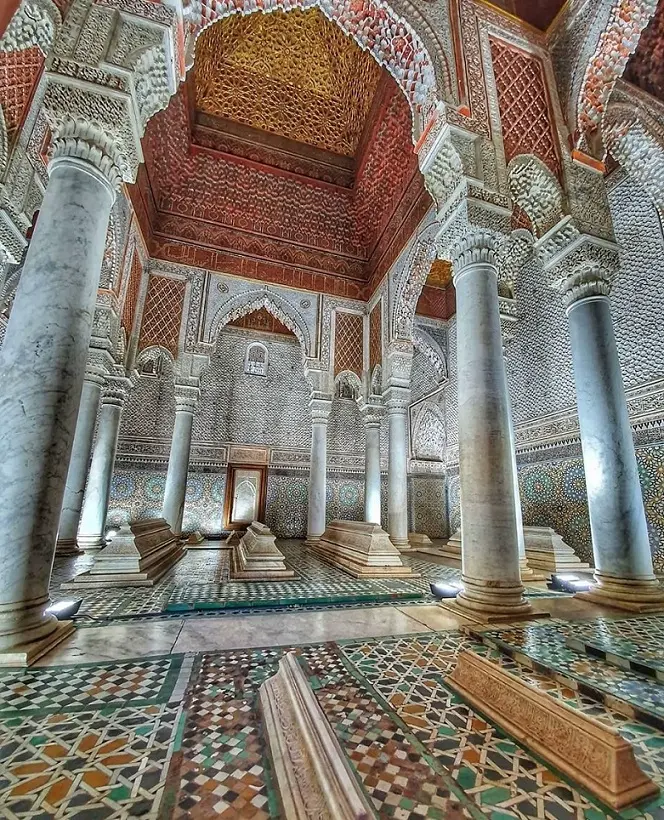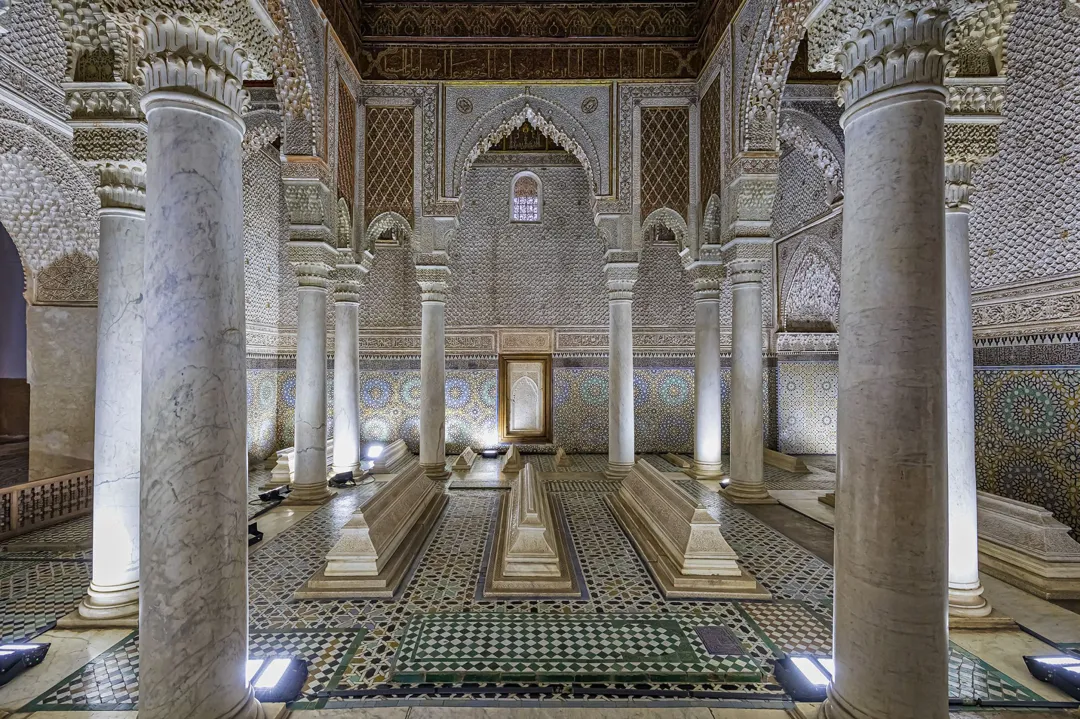Saadian Tombs: Unveiling the Secrets of Morocco’s Royal Necropolis
The Hidden Jewel of Marrakech’s Ancient Kasbah
The Saadian Tombs represent one of Morocco’s most spectacular architectural treasures—a royal necropolis dating back to the glorious Saadian dynasty that once ruled Morocco. Hidden for centuries and only rediscovered in 1917, these tombs showcase some of the finest examples of Islamic craftsmanship in North Africa, with their breathtaking mosaics, intricate woodwork, and delicate stucco decorations.
Whether you’re a history enthusiast, architecture lover, or simply a curious traveler, the Saadian Tombs offer a remarkable glimpse into Morocco’s golden age. This guide covers everything you need to know about visiting this magnificent historical site, from its fascinating history to practical tips for making the most of your visit.
What are the Saadian Tombs? The Saadian Tombs are an elaborate burial ground built during the late 16th century for Sultan Ahmad al-Mansur and his family. Located in Marrakech’s historic Kasbah district, they represent the pinnacle of Moroccan Andalusian architectural style and have become one of the city’s most visited historical sites.
The Remarkable History of the Saadian Tombs
The Rise and Fall of the Saadian Dynasty
The Saadian dynasty emerged in the 16th century as a powerful force in Morocco, originating from the Draa Valley in the south. Rising to prominence through their resistance against Portuguese invaders, the Saadians established Marrakech as their capital and ruled Morocco from 1549 to 1659.
Under Sultan Ahmad al-Mansur (1578-1603), nicknamed “the Golden” for his wealth and the prosperity he brought to Morocco, the dynasty reached its zenith. Al-Mansur expanded Morocco’s territories, engaged in profitable trade with Europe, and initiated numerous impressive building projects across the country.
The Vision of Sultan Ahmad al-Mansur
“Sultan Ahmad al-Mansur was determined that his final resting place would reflect the glory of his reign and stand as a testament to the artistic achievements of his era.”
Al-Mansur’s decision to construct the lavish tombs came from both religious piety and political calculation. As a sharif (descendant of the Prophet Muhammad), he wanted to emphasize his religious legitimacy while demonstrating the wealth and artistic sophistication of his realm.
Construction began around 1587, with al-Mansur importing the finest materials and recruiting the most skilled artisans from across his empire. No expense was spared in creating a mausoleum worthy of a sultan who had transformed Morocco into a powerful kingdom.
The Hidden Centuries
Following the fall of the Saadian dynasty in the mid-17th century, their successor, Sultan Moulay Ismail of the Alaouite dynasty, was determined to erase their legacy. Rather than destroying the tombs (which would have been considered sacrilegious), he ordered them sealed off, with only a small passageway from the adjacent mosque maintaining access.
For nearly 250 years, the magnificent tombs lay forgotten by the wider world, preserved in silence behind their walls while Marrakech continued to evolve around them.
The Dramatic Rediscovery
In 1917, during the French Protectorate period in Morocco, aerial photography revealed the existence of an unknown structure within the Kasbah area. French General Hubert Lyautey commissioned an investigation, leading to one of the most remarkable archaeological discoveries in Morocco’s history.
When workers broke through the walls, they found the tombs almost perfectly preserved a time capsule of Saadian splendor untouched by time or looters. The French authorities immediately recognized the historical and artistic significance of the discovery and initiated restoration efforts to preserve this architectural treasure.
Preservation Through the Ages
Since their rediscovery, the Saadian Tombs have undergone several careful restoration projects aimed at preserving their fragile decorations while making the site accessible to visitors. The most recent major conservation work took place in 2012-2015, focusing on stabilizing the structures and protecting the delicate plasterwork from moisture damage.
Architectural Splendor and Artistic Excellence

The Saadian Tombs complex consists of three main areas: the magnificent Hall of Twelve Columns, the Hall of Three Niches, and an extensive garden courtyard containing over 100 graves. The site perfectly exemplifies the Moroccan-Andalusian architectural style that flourished during the Saadian period.
Layout of the Complex
The complex is arranged around a central axis, with the most important mausoleums positioned at the southern end. Visitors enter through a narrow passageway that opens into the garden courtyard, with the grand chambered tombs visible directly ahead.
The Hall of Twelve Columns
The breathtaking Hall of Twelve Columns (also known as the Chamber of the Twelve Pillars) represents the pinnacle of Saadian artistry and houses the tomb of Sultan Ahmad al-Mansur himself. The name derives from the twelve magnificent columns of Italian Carrara marble that support the ornate cedar ceiling.
Every surface in this chamber showcases extraordinary craftsmanship:
- Ceilings: Carved from fragrant cedarwood imported from the Middle Atlas Mountains, gilded with pure gold, and arranged in elaborate geometric patterns known as muqarnas (honeycomb vaulting).
- Walls: Adorned with intricate zellij (mosaic tilework) in patterns of blue, green, and white, rising halfway up the walls before transitioning to delicate stucco carvings.
- Stucco Decorations: The upper walls and ceilings feature incredibly detailed plasterwork with Islamic geometric patterns, floral designs, and calligraphy from the Quran.
- Tombs: The marble tombstones are themselves works of art, carved with poetic inscriptions and set within the richly decorated floor.
The quality of light filtering through the small, high windows creates an atmosphere of serene contemplation, illuminating the golden decorations in a way that must have seemed almost supernatural to visitors centuries ago.
The Hall of Three Niches
Adjacent to the main hall lies the slightly smaller but equally impressive Hall of Three Niches. This chamber contains the tombs of several princes and important members of the royal family.
The hall’s name comes from the three recessed arches (niches) in its eastern wall. The decorative style here is similar to the main hall but distinct in its patterns and arrangements, showcasing the diversity of Moroccan ornamental techniques even within a single complex.
The Mausoleum of Lalla Messaouda
This separate chamber honors al-Mansur’s mother, Lalla Messaouda. Though smaller than the main halls, it displays equally fine craftsmanship, with particular attention paid to the intricate cedar ceiling and the carved epitaph adorning her tomb.
The Garden Courtyard and Lesser Tombs
The garden courtyard contains over 100 graves of lesser royals, court officials, and royal servants. Though these outdoor tombs are simpler than those in the main chambers, many feature beautiful carved stonework and inscriptions that tell the stories of those interred there.
Traditional Moroccan cemetery plants, including myrtle and rosemary (believed to comfort the dead), create a fragrant and peaceful atmosphere throughout the courtyard.
Islamic Funerary Art and Symbolism
The decorations throughout the Saadian Tombs are not merely aesthetic they carry deep symbolic meaning within Islamic tradition:
- Geometric Patterns: Represent the infinite nature of Allah and the mathematical order of creation.
- Calligraphy: Quranic verses selected specifically for funerary context, offering prayers for the deceased and reminders of resurrection.
- Muqarnas (Honeycomb Structures): Symbolize the complexity and perfection of divine creation.
- Absence of Human Figures: In keeping with Islamic artistic traditions, the decorations avoid depicting humans or animals, focusing instead on abstract patterns, floral motifs, and calligraphy.
Notable Figures and Royal Inhabitants
While Sultan Ahmad al-Mansur’s tomb remains the centerpiece of the complex, many other significant historical figures rest within these walls:
- Sultan Abdullah al-Ghalib: Al-Mansur’s father and predecessor, whose tomb predates the main complex.
- Prince Ahmad al-Mansur: The sultan’s young son who died before him, buried in an exquisitely decorated tomb near his father.
- Royal Wives and Concubines: Several of the sultan’s wives rest in specially designated areas, their tombs identified by poetic inscriptions praising their beauty and virtue.
- Court Officials: Trusted advisors, military commanders, and religious scholars who served the dynasty found their final resting place close to their sovereign.
Each tombstone tells a story, with inscriptions that provide fascinating glimpses into the lives and relationships of Saadian court society.
Planning Your Visit
Location & How to Get There
The Saadian Tombs are located in the Kasbah district of Marrakech’s medina, approximately a 20-minute walk south of Jemaa el-Fna square.
By Foot: From Jemaa el-Fna, follow signs to Bab Agnaou (a prominent historic gate) and continue past El Badi Palace. The entrance to the tombs is somewhat hidden down a narrow passageway next to the Kasbah Mosque.
By Taxi: Any taxi driver will know the location. Expect to pay around 30-40 dirhams from the new city (Gueliz) or 20 dirhams from Jemaa el-Fna.
Coordinates: 31.6167° N, 7.9833° W
Opening Hours & Best Times to Visit
| Day | Hours |
|---|---|
| Monday to Sunday | 9:00 AM – 5:00 PM |
Note: Hours may change during Ramadan, typically closing earlier around 4:00 PM.
Best Times to Visit:
- Early Morning (9:00-10:30 AM): Arrive right at opening to beat the tour groups and enjoy the site in relative tranquility.
- Late Afternoon (3:30-5:00 PM): Often less crowded as day-trippers have moved on to other attractions.
- Avoid: Mid-day, especially between 11:00 AM and 2:00 PM, when large tour groups are most common.
Pro Tip: Local tour operator Sahara Discovery offers early access morning tours that include the Saadian Tombs as part of their Marrakech heritage experience, often allowing visitors to enter before the largest crowds form.
Entrance Fees & Tickets
- Adults: 100 dirhams (approximately $10 USD)
- Children under 12: Free
- Moroccan Citizens/Residents: 10 dirhams
Tickets cannot be purchased online in advance and must be bought at the entrance. Cash payment in Moroccan dirhams is preferred, though some credit cards are accepted.
Time Needed
Most visitors spend between 30-60 minutes exploring the tombs. While the site isn’t large, the extraordinary detail of the decorations rewards careful observation and a slower pace.
Guided Tours vs. Self-Guided Visits
Official Guides: Available at the entrance for approximately 100-150 dirhams for a 30-45 minute tour. Official guides wear badges and can provide valuable historical context and point out easily missed details.
Self-Guided: The site has some informational panels in English, French, and Arabic. If you’ve done some research beforehand (like reading this guide!), a self-guided visit can be equally rewarding and allows you to move at your own pace.
Audio Guides: Not currently available at the site.
Photography Tips
- Lighting: Morning light tends to be best for photographing the interior chambers.
- No Flash: Flash photography is prohibited to protect the delicate decorations.
- Best Angles: The view looking up at the cedar ceilings provides spectacular shots of the geometric patterns.
- Detail Shots: Bring a camera capable of capturing close-ups of the intricate tilework and carvings.
- No Professional Equipment: Tripods and professional photography equipment may require special permission.
Accessibility
The site presents challenges for visitors with mobility issues:
- Narrow entrance passageway
- Several steps within the complex
- No ramps or elevators
Unfortunately, there are currently no dedicated facilities for visitors with disabilities, though staff will generally try to accommodate special disabled when possible.
What to Wear
As this is a historical site rather than an active religious location, there are no strict dress requirements. However, as with all cultural sites in Morocco, modest attire is appreciated:
- Shoulders covered
- Knees covered
- No revealing clothing
Facilities
- Toilets: Available near the exit (small fee of 2-5 dirhams typically expected)
- Water: Not available on site; bring your own, especially in summer
- Gift Shop: Small shop selling books and souvenirs near the exit
- Cafes: None within the complex, but several cafes available within a 5-minute walk
What to Expect & Insider Tips
“Wow” Moments Not to Miss
- The Cedar Ceiling: Look up in the Hall of Twelve Columns to appreciate the extraordinary geometric patterns and gold detailing.
- Marble Tombstones: The inscriptions tell fascinating stories about the deceased.
- Light Play: Watch how sunlight filters through the small windows, creating dramatic effects on the decorations.
- Domed Ceiling: The muqarnas (honeycomb) architecture in the main chamber creates an almost hypnotic effect when viewed from directly below.
Managing Queues
- Ticket Line: Can be long during peak season (March-May and September-November). Arrive early or late in the day to minimize waiting.
- Main Chamber Access: The Hall of Twelve Columns may have a separate queue during busy periods, as staff limit the number of visitors inside at any one time.
- Photography Spots: Popular angles can get crowded. Be patient and respectful of others trying to capture the same views.
- Guided Option: Consider booking a cultural tour with Sahara Discovery, a reputable local travel company that includes the Saadian Tombs in their Marrakech city tours—their guides often help bypass the longest queues.
Visitor Flow
The site has a semi-prescribed route:
- Enter through the narrow passageway
- Emerge into the garden courtyard
- View the outdoor tombs
- Visit the main chambered tombs
- Exit through a different passageway leading to the gift shop
Nearby Attractions to Combine With Your Visit
Make the most of your time in the Kasbah area by visiting these nearby sites:
- El Badi Palace: Just a 5-minute walk away, these atmospheric ruins were once a magnificent palace built by the same sultan who created the tombs.
- Bahia Palace: A 10-minute walk northeast, showcasing 19th-century Moroccan architecture at its finest.
- Kasbah Mosque: Adjacent to the tombs, though only Muslims may enter.
- Mellah (Jewish Quarter): A 15-minute walk east, with its distinctive architecture and historic synagogue.
Expanding Your Moroccan Adventure
After exploring the historical treasures of Marrakech, many travelers wish to venture further into Morocco’s diverse landscapes. Sahara Discovery offers expertly guided tours ranging from 1-day excursions to multi-day adventures:
- Day Trips: Visit the nearby Atlas Mountains, Ourika Valley, or Ouzoud Waterfalls and return to Marrakech by evening.
- 3-5 Day Tours: Experience the magic of spending a night under the stars in the Sahara Desert at Erg Chebbi or Erg Chigaga, with stops at iconic locations like Aït Benhaddou and the Todra Gorge.
- Custom Cultural Itineraries: Sahara Discovery can arrange specialized historical tours connecting Marrakech’s monuments (including the Saadian Tombs) with Morocco’s other imperial cities and archaeological sites.
Frequently Asked Questions
How old are the Saadian Tombs? The main structures were built between 1587 and 1603, making them approximately 430 years old.
Why were the Saadian Tombs hidden for so long? After the fall of the Saadian dynasty, Sultan Moulay Ismail wanted to erase their legacy but considered it sacrilegious to destroy graves. He chose to seal up the tombs instead, and they remained hidden until 1917.
Who discovered the Saadian Tombs? They were rediscovered during the French Protectorate period when aerial photography revealed their existence, leading to their excavation and restoration.
What is the best time of year to visit the Saadian Tombs? Spring (March-May) and autumn (September-November) offer the most pleasant weather for exploring Marrakech and its historical sites.
Are the Saadian Tombs still used for burials? No, the site functions purely as a historical monument and museum today.
How much time should I allocate for visiting the Saadian Tombs? While a rushed visit could take as little as 20 minutes, we recommend allowing 45-60 minutes to fully appreciate the architectural details and historical significance.
Can I visit the Saadian Tombs as part of a larger Morocco trip? Absolutely! Many visitors incorporate the Saadian Tombs into broader Morocco itineraries. Companies like Sahara Discovery offer comprehensive tour packages that start in Marrakech (including the tombs) before venturing to destinations like Essaouira, Fes, Chefchaouen, or into the Sahara Desert for authentic desert camping experiences.
Is it worth hiring a guide for the Saadian Tombs? While not essential, a knowledgeable guide can significantly enhance your understanding of the tombs’ historical and artistic significance. Sahara Discovery’s guides are particularly well-versed in the symbolism and stories behind the decorative elements.




